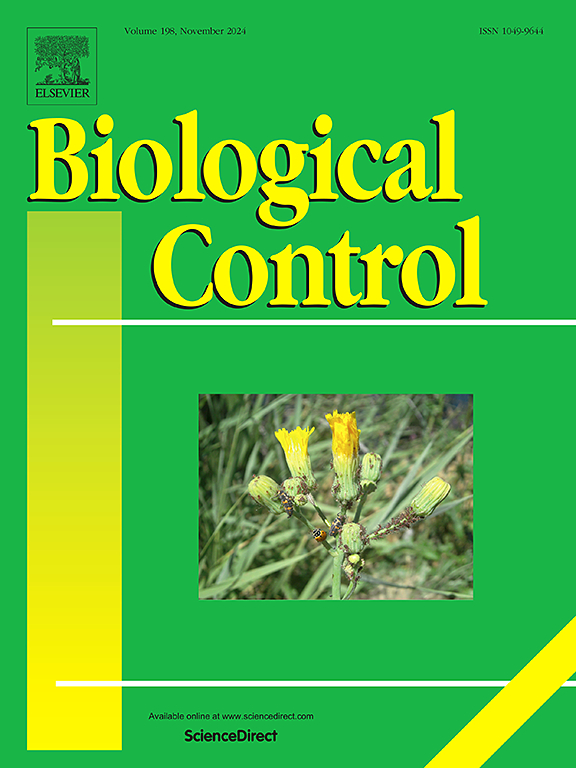A Pseudomonas-based bio-formulation to control bacterial blight of pomegranate caused by Xanthomonas axonopodis pv. punicae
IF 3.4
2区 农林科学
Q2 BIOTECHNOLOGY & APPLIED MICROBIOLOGY
引用次数: 0
Abstract
Plant growth-promoting bacteria (PGPB) have emerged as sustainable tool for managing plant diseases. This study investigates the potential of a Pseudomonas-based biocontrol agent to manage bacterial blight (BB) in pomegranate. This major disease is caused by Xanthomonas axonopodis pv. punicae (Xap) and it is traditionally controlled with antibiotics. Of the 151 bacterial isolates obtained from the pomegranate rhizosphere, three (UHSPS15A, UHSPS33, and UHSPS54) demonstrated the strongest inhibitory effects against Xap in vitro, and their identification as Pseudomonas was confirmed through DNA analysis. Greenhouse trials with Xap-inoculated plants revealed that preventive application of each of the three isolates was more effective than curative, with UHSPS15A providing the highest protection. A talc-based formulation was developed using UHSPS15A. After evaluating its stability and efficacy in greenhouse Xap-inoculated pomegranates plants, open-fields trials indicated that among the three different treatment modes tested, the combined soil and foliar application achieved the highest disease protection and fruit yield, topping the standard antibiotic control. These findings recommend that integrating Pseudomonas-based bio-formulations into disease management strategies could significantly reduce reliance on synthetic chemicals, offering a sustainable alternative for controlling BB in pomegranate.
以假单胞菌为基础的防治石榴细菌性枯萎病的生物制剂。punicae
植物促生长细菌(PGPB)已成为植物病害管理的可持续工具。本研究探讨了以假单胞菌为基础的生物防治剂对石榴细菌性枯萎病(BB)的防治潜力。这种主要疾病是由轴索黄单胞菌引起的。传统上是用抗生素控制的。从石榴根际分离得到的151株细菌中,有3株(UHSPS15A、UHSPS33和UHSPS54)对Xap的体外抑制作用最强,通过DNA分析证实其为假单胞菌。用xap接种植株进行的温室试验表明,三种分离株的预防施用均比治疗施用更有效,其中UHSPS15A提供了最高的保护。以UHSPS15A为原料研制了滑石基配方。在温室接种xap的石榴植株上对其稳定性和有效性进行评价后,大田试验表明,在3种不同处理模式中,土叶结合施用的防病效果和果实产量最高,优于标准抗生素防治。这些发现表明,将基于假单胞菌的生物制剂整合到疾病管理策略中可以显着减少对合成化学品的依赖,为控制石榴中的BB提供了可持续的替代方案。
本文章由计算机程序翻译,如有差异,请以英文原文为准。
求助全文
约1分钟内获得全文
求助全文
来源期刊

Biological Control
生物-昆虫学
CiteScore
7.40
自引率
7.10%
发文量
220
审稿时长
63 days
期刊介绍:
Biological control is an environmentally sound and effective means of reducing or mitigating pests and pest effects through the use of natural enemies. The aim of Biological Control is to promote this science and technology through publication of original research articles and reviews of research and theory. The journal devotes a section to reports on biotechnologies dealing with the elucidation and use of genes or gene products for the enhancement of biological control agents.
The journal encompasses biological control of viral, microbial, nematode, insect, mite, weed, and vertebrate pests in agriculture, aquatic, forest, natural resource, stored product, and urban environments. Biological control of arthropod pests of human and domestic animals is also included. Ecological, molecular, and biotechnological approaches to the understanding of biological control are welcome.
 求助内容:
求助内容: 应助结果提醒方式:
应助结果提醒方式:


